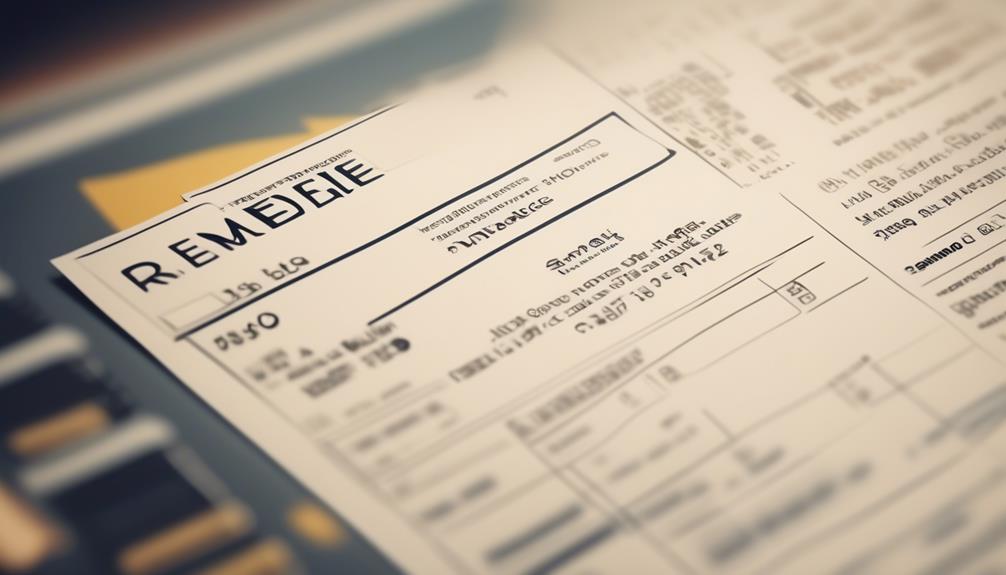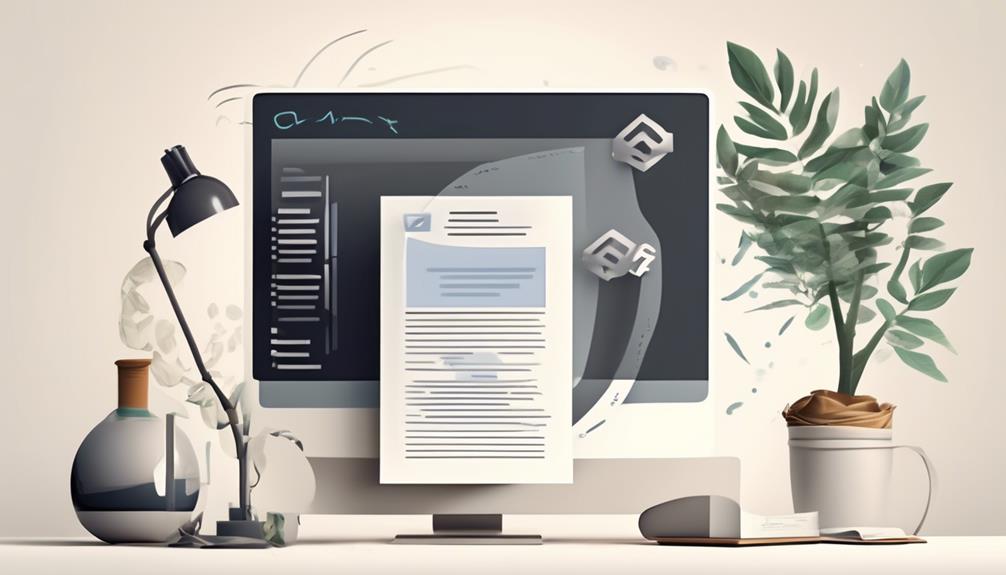Purely by chance, our investigation has prompted us to assess how effective it is to use email templates for remittance advice as our method for payment notifications.
It's become increasingly important to streamline our communication with vendors and suppliers, and utilizing a standardized format could be the key.
But are we making the most of this tool?
Let's uncover the benefits and best practices for implementing remittance advice email templates to enhance our payment processes and vendor relationships.
Key Takeaways
- Remittance advice is a crucial document in financial transactions, providing confirmation of payment and essential transaction details.
- Sending remittance advice electronically, often via email, enhances transparency and efficiency in payment processes.
- The format for issuing remittance advice should include important details such as the date, recipient's details, payment amount, and invoice number.
- A remittance advice email should have a clear subject line, detailed invoice information, express gratitude, and provide contact information for issue resolution.
Definition of Remittance Advice
Remittance advice is a crucial document that provides confirmation of payment, typically sent by a payer to a payee, in various financial transactions. It serves as a notification to the recipient that a payment has been made and provides essential details regarding the transaction.
The remittance advice includes payment details such as the amount paid, the date of payment, the invoice number, and any relevant information necessary for the recipient to reconcile the payment with their accounts receivable.
In the context of accounts payable, the remittance advice serves as a valuable record for the recipient to update their financial records and mark the corresponding invoice as paid. Similarly, in accounts receivable, the remittance advice assists the recipient in matching the incoming payment with the outstanding invoices, ensuring accurate tracking of payments.
This document is commonly sent electronically, often in the form of a remittance advice email. It plays a pivotal role in streamlining the payment remittance process, providing clarity and transparency to both the payer and the payee.
Understanding the definition and significance of remittance advice is essential for effective financial management and maintaining accurate transaction records.
Types of Remittance Advice Users

In understanding the dynamics of remittance advice, it becomes essential to identify the various stakeholders involved in the remittance advice process. There are several types of users who engage with remittance advice documents, either through email templates, remittance slips, or accounting software. The table below outlines the key types of remittance advice users and their roles in the payment process:
| User Type | Description | Involvement |
|---|---|---|
| Vendors/Suppliers | Receives remittance advice email templates | Send invoices, receive payments, reconcile accounts |
| Accounts Receivable | Generates and sends remittance advice documents | Issues invoices, processes payments, updates accounting records |
| Buyers/Clients | Utilizes online payment systems | Make payments, review remittance advice, manage accounts payable |
| Accounting Staff | Uses accounting software to manage remittance information | Verify payments, reconcile accounts, generate financial reports |
Understanding the roles of these users is crucial for streamlining the remittance advice process and ensuring efficient payment management.
Format for Issuing Remittance Advice
As we explore the format for issuing remittance advice, it's crucial to recognize the pivotal roles of various users involved in the remittance advice process.
When sending remittance advice, the format should include essential details such as the date, recipient's details, payment amount, invoice number, and proof of payment.
The most common method of sending remittance advice is through email. An effective format for issuing remittance advice via email should include a clear subject line indicating 'Remittance Advice for [Invoice Number]', a formal salutation, a concise body providing payment details, and a polite closing remark.
The email may also include attachments such as remittance advice slips or proof of payment for the recipient's records. It's important to ensure that the email is sent to the correct recipient's email address and that the information provided is accurate.
This format for issuing remittance advice via email ensures that the recipient is promptly informed of the payment, contributing to transparent and efficient payment processing while providing a documented proof of payment for both parties.
Components of a Remittance Advice Email

While crafting a remittance advice email, it's essential to incorporate key components that ensure prompt attention and facilitate seamless communication.
The email should have a clear subject line and sender information to prompt attention and understanding.
Including detailed invoice information and payment specifics allows for easy reference and verification.
Expressing gratitude with a thank-you message strengthens business relationships and fosters goodwill.
Furthermore, providing contact information and customer support details enables swift issue resolution and further communication if necessary.
Integration with payment processing and accounting apps streamlines the remittance process, enhancing efficiency for both the sender and the recipient.
Additionally, the email should include the sender's email address, payment type, and available payment methods for the recipient's convenience.
This comprehensive approach to sending a remittance ensures that vendors and suppliers have all the necessary information to process online payments promptly once an invoice is paid.
A well-structured remittance advice email template with these components can significantly improve the overall payment process.
Creating and Sending Remittance Advice
We create and send remittance advice to provide confirmation of payment and facilitate efficient management of accounts receivable. Our process involves generating an email template that includes essential details such as the invoice paid, payment information, and any relevant references.
For small businesses, manually creating and sending remittance advice can be time-consuming, especially when dealing with a high volume of transactions. To streamline this process, some businesses opt for systems that can automatically generate remittance advice based on received payments.
When sending remittance advice, it's crucial to ensure that the recipient can easily match the advice with the corresponding payment. Additionally, different payment methods may require varying levels of detail in the remittance advice. For instance, when a wire transfer is used, the remittance advice may need to include specific banking information. Moreover, in cases where the payment is made through a credit union, the remittance advice should align with the requirements of the financial institution.
Frequently Asked Questions
How Do You Send Remittance Advice via Email?
We send remittance advice via email by attaching the necessary documentation and providing a clear and concise explanation of the payment made. This ensures that our vendors and suppliers receive timely and accurate information, allowing them to efficiently track their invoices and payment status.
Sending remittance advice via email demonstrates our commitment to professionalism and helps maintain strong business relationships. It shows that we value clear and open communication with our partners.
Additionally, sending remittance advice via email streamlines the payment process. This benefits both parties involved by simplifying the tracking and reconciliation of payments. It also improves overall efficiency by eliminating the need for manual or paper-based processes.
What Is an Example of a Remittance Advice Email?
Sure,
An example of a remittance advice email could include a brief introduction.
Followed by the details of the payment, such as the invoice number, amount, and payment date.
It should also include instructions for any necessary follow-up actions, such as confirming receipt of the payment or updating account records.
The email should be clear, concise, and include all relevant information for the recipient to easily process the remittance.
How Do You Write a Payment Advice for Email?
We write payment advice emails by providing clear subject lines and sender information to convey purpose. Including detailed invoice and payment information ensures a comprehensive overview.
Expressing gratitude for the business relationship conveys professionalism. We integrate email with payment processing and accounting apps for efficiency. Contact information and customer support details are included for further assistance.
As the adage goes, 'actions speak louder than words,' so we ensure our emails are informative and supportive.
How Do I Write a Remittance Letter?
We write a remittance letter by including the date, recipient's name, and address at the top.
We then state the purpose of the letter and provide payment details such as the amount, payment method, and any relevant invoice numbers.
It's important to express gratitude and provide contact information for any inquiries.
This ensures clarity and professionalism in our communication, facilitating smooth transaction processes.
Conclusion
In conclusion, utilizing a remittance advice email template is a crucial tool for businesses to streamline their payment notifications and maintain strong relationships with vendors and suppliers.
By ensuring consistent and detailed communication, businesses can improve their efficiency and keep track of their financial transactions.
Just as a well-oiled machine runs smoothly, so too can a business with the use of a reliable remittance advice email template.










